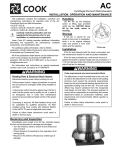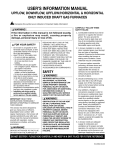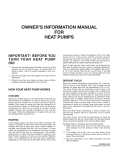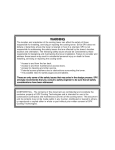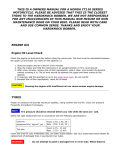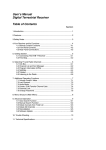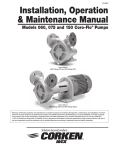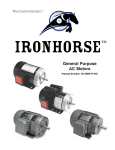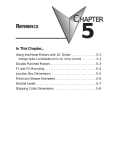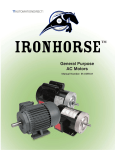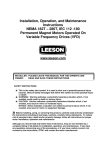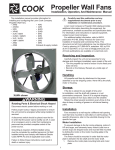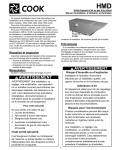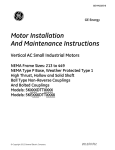Download SQI - Loren Cook Company
Transcript
SQI Square Centrifugal Inline Fan INSTALLATION, OPERATION, AND MAINTENANCE MANUAL This publication contains the installation, operation and maintenance instructions for standard units of the SQI Square Centrifugal Inline Fans. Carefully read this publication and any supplemental documents prior to any installation or maintenance procedure. Loren Cook catalog SQI provides additional information describing the equipment, fan performance, available accessories, and specification data. For additional safety information, refer to AMCA publication 410-96, Safety Practices for Users and Installers of Industrial and Commercial Fans. All of the publications listed above can be obtained from Loren Cook Company by phoning (417)869-6474, extension 166; by FAX at (417)832-9431; or by e-mail at [email protected]. For information on special equipment, contact Loren Cook Company Customer Service Department at (417)869-6474. Rotating Parts & Electrical Shock Hazard: Disconnect electric power before working on unit. Follow proper lockout / tagout procedures to ensure the unit cannot be energized while being installed or serviced. A disconnect switch should be placed near the fan in order that the power can be swiftly cut off, in case of an emergency and in order that maintenance personnel are provided complete control of the power source. Grounding is required. All field-installed wiring must be completed by qualified personnel. All fieldinstalled wiring must comply with National Electric Code (NFPA 70) and all applicable local codes. Storage If fan is stored for any length of time, prior to installation, completely fill bearings with grease or moisture-inhibiting oil. Refer to page 4. Store the fan in its original crate and protect from dust, debris, and weather. To maintain good working condition of a SQL when it’s stored outdoors, or on a construction site follow the additional steps below. • Cover the inlet and outlet, and belt tunnel opening to prevent accumulation of dust and moisture in the housing. • Periodically rotate the wheel and operate dampers (if supplied) to keep a coating of grease on all internal bearing parts. • Periodically inspect the unit to prevent damaging conditions. Installation To prevent damage to the fan during shipping, motors 5 HP and larger, and extremely heavy motors (cast iron or severe duty) are shipped loose and must be field mounted by bolting the motor on the motor mounting plate in the existing mounting slots. Wiring Installation NOTICE! All wiring should be in accordance with local ordinances and the National Electrical Code, NFPA 70. Ensure the power supply (voltage, frequency, and current carrying capacity of wires) is in accordance with the motor nameplate. Refer to the Wiring Diagrams, on page 3. Direct drive - Wire the electrical box on the blower housing. Belt drive - The motor can be wired directly since the motor is external to the fan. Failure to follow these instructions could result in death or serious injury. Receiving and Inspection Carefully inspect the fan and accessories for any damage and shortage immediately upon receipt of the fan. • Turn the wheel by hand to ensure it turns freely and does not bind. • Inspect dampers for free operation of all moving parts. • Record on the Delivery Receipt any visible sign of damage. Handling Lift the fan by the base or lifting eyes. NOTICE! Never lift by the shaft, motor, or housing. SQI-B Motor Plate Motor Plate Adjustment Nut Tolerance OFFSET Center Distance Maximum Gap Up thru 12” 12” up through 48 Over 48” 1/16” 1/8” 1/4” ANGULAR OFFSET/ANGULAR A W CENTER DISTANCE X (CD) Y Motor Plate Adjustment Wiring Installation (continued) Leave enough slack in the wiring to allow for motor movement when adjusting belt tension. Some fractional motors have to be removed in order to make the connection with the terminal box at the end of the motor. To remove motor, remove bolts securing motor base to power assembly. Do not remove motor mounting bolts. Belt and Pulley Installation Belt tension is determined by the sound the belts make when the fan is first started. Belts will produce a loud squeal which dissipates after the fan is operating at full capacity. If the belt tension is too tight or too loose, lost efficiency and possible damage can occur. 1/4 Figure 2 inch B GAP GAP NOTICE! Do not allow the fan to run in the wrong direction. This will overheat the motor and cause serious damage. For 3-phase motors, if the fan is running in the wrong direction, check the control switch. It is possible to interchange two leads at this location so that the fan is operating in the correct direction. t oo 1f Z Final Installation Steps a. Ensure that all accessories are installed. b. Ensure that the blower is secured to ductwork. c. Inspect wheel-to-inlet clearance. Ensure wheel does not rub against the inlet. d. Test the fan to ensure the rotation of the wheel is the same as indicated by the rotation label. Figure 3 e. Inspect for correct amperage with an ammeter and correct voltage with a voltmeter. Operation Pre-Start Checks a. Lock out all the primary and secondary power sources. b. Inspect and tighten fasteners and setscrews, particularly fan mounting and bearing fasteners. Refer to Torque chart. c. Inspect belt tension and pulley alignment. d. Inspect motor wiring. e. Ensure fan and ductwork are clean and free of debris. f. Close and secure all access doors. g. Restore power to the fan. Figure 1 Do not change the pulley pitch diameter to change tension. This will result in a different fan speed. a. Loosen motor plate adjustment nuts on stud bolts and move motor plate in order that the belts can easily slip into the grooves on the pulleys. Never pry, roll, or force the belts over the rim of the pulley. b. Adjust the motor plate until proper tension is reached. For proper tension, a deflection of approximately 1/4” per foot of center distance should be obtained by firmly pressing the belt. Refer to Figure1. c. Lock the motor plate adjustment nuts in place. d. Ensure pulleys are properly aligned. Refer to Figure 2. Start Up Turn the fan on. In variable speed units, set the fan to its lowest speed and inspect for the following: • Direction of rotation. • Excessive vibration. • Unusual noise. • Bearing noise. • Improper belt alignment or tension (listen for squealing). • Improper motor amperage or voltage. NOTICE! If a problem is discovered, immediately shut the fan off. Lock out all electrical power and check for the cause of the trouble. See Troubleshooting. Pulley Alignment Pulley alignment is adjusted by loosening the motor pulley setscrew and by moving the motor pulley on the motor shaft. Figure 2 indicates where to measure the allowable gap for the drive alignment tolerance. All contact points (indicated by WXYZ) are to have a gap less than the tolerance shown in the table. When the pulleys are not the same width, the allowable gap must be adjusted by half of the difference in width. Figure 3 illustrates using a carpenter’s square to adjust the position of the motor pulley until the belt is parallel to the longer leg of the square. Inspection Inspection of the fan should be conducted at the first 30 minute, 8 hour and 24 hour intervals of satisfactory operation. During the inspections, stop the fan and inspect as per the chart below. 2 Wiring Diagrams Wiring Diagrams Single Speed, Single Phase Motor 3 Phase, 9 Lead Motor Delta-Connection 3 Phase, 9 Lead Motor Y-Connection Low Voltage 208/230 Volts High Voltage Low Voltage 460 Volts 208/230 Volts 4 5 6 4 5 6 7 6 1 7 8 9 1 7 When ground is required, attach to ground A or B with no. 6 thread forming screw. To reverse, interchange T-1 and T-4. 2 3 8 9 L1 L2 L3 3 L1 L1 L2 L3 L2 9 5 3 4 5 6 1 2 3 L3 L1 L2 L3 To reverse, interchange any 2 line leads. 2 Speed, 1 Winding, 3 Phase Motor 2 Speed, 2 Winding, Single Phase Motor High Speed 1 Together 2 3 Ground A High Speed T-1 T-4 1 2 8 4 2 High Voltage 460 Volts 7 8 9 L1 Line L2 Motor Low Speed Ground B 4 5 6 L1 L2 Line L3 Low Speed L1 1 L2 Line 2 3 L3 Motor 4 Open 5 6 To reverse, interchange any 2 line leads. Motors require magnetic control. When ground required, attach to ground A or B with No. 6 thread forming screw. To reverse, interchange T-1 and T-4 leads. 2 Speed, 2 Winding, 3 Phase Single Speed, Single Phase, Dual Voltage Ground A Ground A Link A T-5 Link B J-10 Low Voltage L1 Line Link A & B T-5 L1 Line J-10 L2 L2 To reverse: High Speed-interchange leads T11 and T12. Low Speed-interchange leads T1 and T2. Both Speeds-interchange any 2 line leads. Ground B Ground B When ground required, attach to ground A or B with No. 6 thread forming screw. To reverse, interchange T-5 and J-10 leads. Typical Damper Motor Schematic L3 L2 L1 Fan Motor Transformer** Damper Motor* Transformer** Second Damper Motor SQI-D 70-90 For 3 phase, damper motor voltage should be the same between L1 and L2. For single phase application, disregard L 3. *Damper motors may be available in 115, 230 and 460 volt models. The damper motor nameplate voltage should be verified prior to connection. **A transformer may be provided in some installations to correct the damper motor voltage to the specified voltage. White Line Black (High) * Blue (Medium) * Red (Low) * NOTE: Insulate Unused Leads Separately FSC WHITE SQI-D FAN* FSC BLACK *See SQI Wiring Diagram for correct lead. 3 Line around the bearing seals. Excessive grease can damage seal and reduce life through excess contamination and/or loss of lubricant. In the event that the bearing cannot be seen, use no more than three injections with a hand operated grease gun. Conditions Chart 30 Minute Interval Inspect bolts, setscrews, and motor mounting bolts. Adjust and tighten as necessary. 8 Hour Interval Inspect belt alignment and tension. Adjust and tighten as necessary. 24 Hour Interval Inspect belt tension. Adjust and tighten as necessary. RPM Establish a schedule for inspecting all parts of the fan. The frequency of inspection depends on the operating conditions and location of the fan. Inspect fans exhausting corrosive or contaminated air within the first month of operation. Fans exhausting contaminated air (airborne abrasives) should be inspected every three months. Yearly inspections are recommended for fans exhausting non-contaminated air. It is recommended the following inspections be conducted twice per year. • Inspect bolts and setscrews for tightness. Tighten as necessary. Refer to Torque chart. • Inspect belt wear and alignment. Replace worn belts with new belts and adjust alignment as needed. Refer to Belt and Pulley Installation. • Bearings should be inspected as recommended in the Conditions Chart. • Inspect for cleanliness. Clean exterior surfaces only. Removing dust and grease on motor housing assures proper motor cooling. Recommended Torque for Setscrews/Bolts (IN/LB) No.10 1/4” 5/16” 3/8” 7/16” 1/2” 5/8” 3/4” 3/32” 1/8” 5/32” 3/16” 7/32” 1/4” 5/16” 3/8” 6 months 120 to 200 2 months -30 to 120 3 months 120 to 200 1 month -30 to 120 1 month 120 to 200 2 weeks Any Speed < -30 Consult Factory Any Speed > 200 1 week 1000 to 3000 Over 3000 For moist or otherwise contaminated installations; divide the interval by a factor of 3. For vertical shaft installations divide the interval by a factor of 2. Motor Bearings Motors are provided with prelubricated bearings. Any lubrication instructions shown on the motor nameplate supersede instructions below. Direct Drive 1050/1075,1200,1300 &1500 rpm units use a prelubricated sleeve bearing that has a oil saturated wicking material surrounding it. The initial factory lubrication is adequate for up to 10 years of operation under normal conditions. However, it is advisable to add lubricant after 3 years. Use only LIGHT grade mineral oil or SAE 10W oil up to 30 drops. If the unit has been stored for a year or more it is advisable to lubricate as directed above. For VCR direct drive units and other units in severe conditions, lubrication intervals should be reduced to half. Motors without sleeve bearings (as described above) will have grease lubricated ball or roller bearings. Motor bearings without provisions for relubrication will operate up to 10 years under normal conditions with no maintenance. In severe applications, high temperatures or excessive contaminates, it is advisable to have the maintenance department disassemble and lubricate the bearings after 3 years of operation to prevent interruption of service. For motors with provisions for relubrication, follow intervals of the table below Setscrews Key Hex Across Flats Greasing Interval Up to 1000 Maintenance Size Temp °F -30 to 120 Recommended Torque Hold Down Bolts Min. Max. Size 28 66 126 228 348 504 1104 1440 33 80 156 275 384 600 1200 1800 3/8”-16 1/2”-13 5/8”-11 3/4”-10 7/8”-9 1”-8 1-1/8”-7 1-1/4”-7 Wrench Torque 240 600 1200 2100 2040 3000 4200 6000 Fan Bearings Relubrication Intervals NEMA Frame Size Up to and Service 213T-365T 404T and larger including 184T Conditions 1800 RPM Over 1800 1800 RPM Over 1800 1800 RPM Over 1800 and less RPM and less RPM and less RPM Standard 3 yrs. 6 months 2 yrs. 6 months 1 yr. 3 months Severe 1 yr. 3 months 1 yr. 3 months 6 months 1 months The fan bearings are provided prelubricated. Any specialized lubrication instructions on fan labels supersedes information provided herein. Bearing grease is a petroleum lubricant in a lithium base conforming to a NLGI #2 consistency. If user desires to utilize another type of lubricant, they take responsibility for flushing bearings and lines, and maintaining a lubricant that is compatible with the installation. A NLGI #2 grease is a light viscosity, low-torque, rustinhibiting lubricant that is water resistant. Its temperature range is from -30°F to 200°F and capable of intermittent highs of 250°F. Bearings should be relubricated in accordance with the condition chart below. For best results, lubricate the bearing while the fan is in operation. Pump grease in slowly until a slight bead forms Motors are provided with a polyurea mineral oil NGLI #2 grease. All additions to the motor bearings are to be with a comparable grease such as Exxon Mobil Polyrex EM and Chevron SRI. The above intervals should be reduced to half for vertical shaft installations. Motor Services Should the motor prove defective within a one-year period, contact your local Loren Cook Company representative or your nearest authorized electric motor service representative. 4 e. Slide new bearings onto the shaft to the desired location and loosely mount bearings onto the bearing support. Bearing bolts and setscrews should be loose enough to allow shaft positioning. f. Correctly position the wheel and tighten the bearing bolts securely to the bearing plate. g. Align setscrews bearing to bearing and secure tightly to the shaft. Changing Fan Speed All belt driven fans with motors up to and including 5 HP are equipped with variable pitch pulleys. a. Loosen setscrew on motor pulley. b. Open or close the groove facing to change the pitch diameter. Speed Reduction - Open the pulley in order that the belt rests deeper in the groove. Speed Increase - Close the pulley in order that the belt rests higher in the groove. Ensure RPM limits of the fan and the horsepower limits of the motor are maintained. c. Retighten pulley setscrew on one of the flat areas of the motor shaft. d. After the adjustment is made, check for proper belt NOTICE! Never tighten both pairs of setscrews before securing bearing mounting bolts. This may damage the shaft. h. Inspect the wheel position again. If necessary, readjust by loosening the bearing bolts and setscrews and repeat from step e. Wheel Replacement Maximum RPM SQI-B Size 90 120 135 150 165 180 195 210 225 245 270 300 330 365 402 Maximum RPM SQI-HP Size Maximum RPM 3341 2966 2460 2209 2158 1814 1590 1417 1490 1485 1244 1041 992 833 714 135 150 165 180 195 210 225 245 270 300 330 365 402 2624 2692 2687 1958 1901 1702 1797 1775 1525 1271 1208 1000 995 a. Drill two 1/4” diameter holes, 180 apart centered approximately between the shaft and the outside diameter of the hub, 3/8” to 1/2” in depth. b. Tap 1/4” holes to 5/16” thread with a 5/16” hole tap. Do not drill or tap greater than recommended. c. Screw the puller arms to the full depth of the threads into the tapped holes. Align center of the puller with the center of the shaft. Ensure all setscrews in the hub, normally two, are fully removed. d. Slowly remove wheel from the shaft. tension. See the Belt and Pulley Installation section. Pulley and Belt Replacement Above - Drilled hole placement. Right - Wheel puller. a. Remove pulleys from their respective shafts. b. Clean the motor and fan shafts. c. Clean bores of pulleys and coat the bores with heavy oil. d. Remove grease, rust, or burrs from the pulleys and shafts. e. Remove burrs from shaft by sanding. f. Place fan pulley on fan shaft and motor pulley on its shaft. NOTICE! Do not hammer the pulleys onto the shafts because this may damage the bearings. g. Tighten in place. h. Install belts on pulleys and align as described in the Belt and Pulley Installation section. Recommended Puller Lisle No. 45000 Sterling Wheel Puller. This puller is available at most automotive parts retail outlets. Bearing Replacement The SQI-B fan bearings are pillow block ball bearings. a. Remove outer access door. b. Remove bolts/screws to inner housing access doors. Open and remove the inner access door to reveal bearings. c. Remove the old bearing. d. Remove any burrs from the shaft by sanding. 5 Wheel-to-Inlet Clearance The correct wheel-to-inlet clearance is critical to proper fan performance. This clearance should be verified before initial startup since rough handling during shipment could cause a shift in fan components. Refer to wheel/inlet drawing for correct overlap. Adjust the overlap by loosening the wheel hub and moving the wheel along the shaft to obtain the correct value. A uniform radial gap (space between the edge of the cone and the edge of the inlet) is obtained by loosening the inlet cone bolts and repositioning the inlet cone. Size Overlap 70 - 165 3/16” 180 - 245 1/4” 270 - 300 5/16” 330 - 365 3/8” 402 7/16” Troubleshooting Problem and Potential Cause Low Capacity or Pressure •Incorrect direction of rotation. Make sure the fan rotates in same direction as the arrows on the motor or belt drive assembly. •Poor fan inlet conditions. There should be a straight clear duct at the inlet. •Improper wheel alignment. Excessive Vibration and Noise •Damaged or unbalanced wheel. •Belts too loose; worn or oily belts. •Speed too high. •Incorrect direction of rotation. Make sure the fan rotates in same direction as the arrows on the motor or belt drive assembly. •Bearings need lubrication or replacement. Overheated Motor •Motor improperly wired. •Incorrect direction of rotation. Make sure the fan rotates in same direction as the arrows on the motor or belt drive assembly. •Cooling air diverted or blocked. •Improper inlet clearance. •Incorrect fan RPMs. Overheated Bearings •Improper bearing lubrication •Excessive belt tension. 6 SQI-D Parts List 1 2 3 5 6 4 Discharge View Inlet View Air Flow Part No. 1 2 3 4 5 6 Not Shown: 7 8 9 Description Sizes 70-90 Hex Bolts) Inlet Panel Inlet Access Door Electric Box Straightening Vanes Size 120 Hex Bolt Inlet Panel Inlet Access Door Electric Box Straightening Vanes Size 135 Hex Bolt Inlet Panel Inlet Access Door Electric Box Straightening Vanes Sizes 150-165 Hex Bolt Inlet Panel Inlet Access Door Electric Box Straightening Vanes Wheel Assembly — Motor Wheel Assembly — Motor Wheel Assembly — Motor Wheel Assembly Slot Cover Motor 7 SQI-B Parts List 2 3 4 8 6 5 7 1 9 10 Inlet View Discharge View Air Flow Description Part No. 90 - 165 180 - 210 225 - 402 1 Motor Plate Motor Plate Motor Plate 2 Hex Bolt Hex Bolt Hex Bolt 3 Inlet Panel Inlet Panel Inlet Panel 4 Inlet Inlet Inlet 5 Access Door Access Door Access Door 6 Straightening Vane Straightening Vane Straightening Vane 7 Driven Sheave Driven Sheave Driven Sheave 8 Belt Set Belt Set Belt Set 9 Driver Sheave Driver Sheave Driver Sheave 10 Motor Motor Motor Not Shown: 11 Wheel Assembly Wheel Assembly Wheel Assembly 12 Slot Cover Slot Cover Slot Cover 13 Bearings Bearings Bearings 14 Shaft Shaft Shaft Limited Warranty Loren Cook Company warrants that your Loren Cook fan was manufactured free of defects in materials and workmanship, to the extent stated herein. For a period of one (1) year after date of shipment, we will replace any parts found to be defective without charge, except for shipping costs which will be paid by you. This warranty is granted only to the original purchaser placing the fan in service. This warranty is void if the fan or any part thereof has been altered or modified from its original design or has been abused, misused, damaged or is in worn condition or if the fan has been used other than for the uses described in the company manual. This warranty does not cover defects resulting from normal wear and tear. To make a warranty claim, notify Loren Cook Company, General Offices, 2015 East Dale Street, Springfield, Missouri 65803-4637, explaining in writing, in detail, your complaint and referring to the specific model and serial numbers of your fan. Upon receipt by Loren Cook Company of your written complaint, you will be notified, within thirty (30) days of our receipt of your complaint, in writing, as to the manner in which your claim will be handled. If you are entitled to warranty relief, a warranty adjustment will be completed within sixty (60) business days of the receipt of your written complaint by Loren Cook Company. This warranty gives only the original purchaser placing the fan in service specifically the right. You may have other legal rights which vary from state to state. For fans provided with motors, the motor manufacturer warrants motors for a designated period stated in the manufacturer’s warranty. Warranty periods vary from manufacturer to manufacturer. Should motors furnished by Loren Cook Company prove defective during the designated period, they should be returned to the nearest authorized motor service station. Loren Cook Company will not be responsible for any removal or installation costs. Corporate Offices: 2015 E. Dale Street Springfield, MO 65803 417.869.6474 lorencook.com 8 SQI IOM - Jan 2014








